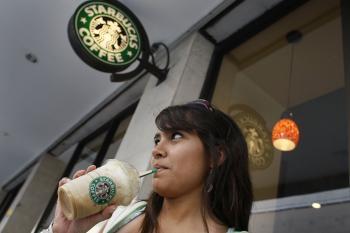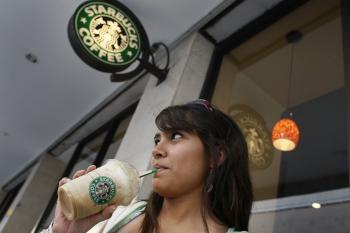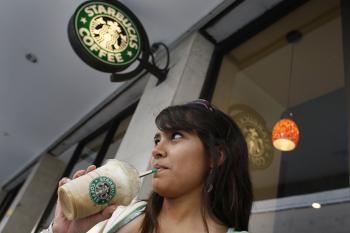WASHINGTON—This month, coffeehouse chain Starbucks Corp. announced the locations of the 616 store closures—16 more than previously anticipated—to be completed by March 2009.
About 54 percent of the store closures are due to close proximity to other Starbucks locations, according to the Seattle Times.
“Poor real estate decisions that were made, coupled with a very troubled economy, convinced us that these stores would not reach acceptable levels of profitability,” explained Starbucks in a recent release.
The message was sweetened with a promise to place many of the affected employees in nearby remaining coffee shops.
In dollar terms, Starbucks estimates a cost of up to $348 million from the store closures, including write-offs, buying out lease contracts, and severance pay.
However, mixed messages are coming from Starbucks headquarters.
Just a few months ago, the company announced that it grew by 12 percent during 2007 and close to 80 percent of its earnings came from stores based in the United States.
Although Howard Shultz, Chairman, CEO and President of Starbucks, hinted that its U.S. operations did not bring the expected earnings, the company predicted in April that it would open 400 stores annually from 2009 through 2011 in the United States and 1,050 internationally.
Wake Up Call
By becoming a public company and subscribing to the typical corporate hyper-growth strategy, some suggest that Starbucks has lost its uniqueness and charm.
“None of [the store closings] need have happened if Starbucks had stayed private and grown at a more controlled pace. To continue to be a premium-priced band while trading as a public company is very challenging,” said John A. Quelch, professor at Harvard Business School, in a recent article on Working Knowledge, Harvard Business School’s publishing arm.
Quelch claims that by catering more to the “grab and go” customer and offering too many new products, Starbucks lost its exclusivity and uniqueness, or what Quelch calls “club-like atmosphere.” Many customers moved on to Peets, Caribou Coffee and other competitors. Many of the “grab and go” customers were not willing to pay for higher-priced Starbuck coffee when they could go to McDonald’s or Dunkin Donuts.
Opening too many stores in close proximities also undercut an individual store’s earning power.
“Eventually, the point of saturation is reached and cannibalization of existing store sales undermines not just brand health but also manager morale,” Quelch claimed.
In early 2007, a leaked Starbucks internal memo from Schultz spoke of a loss of identity in its quest for accelerated growth.
Schultz candidly admits to his part in the cultural change and subsequent loss of what made Starbucks unique to its customers. But he was certain that any equipment modernization and redesign of store appearances could not be faulted, although each subsequent Starbucks redesign distanced the preparation and aroma of coffee from the customer.
“One of the results has been stores that no longer have the soul of the past and reflect a chain of stores vs. the warm feeling of a neighborhood store. Some people even call our stores sterile, cookie cutter, no longer reflecting the passion our partners feel about coffee,” Schultz said in the memo.
The memo was first made public on the Starbucks Gossip Web site, a blog maintained by Jim Romenesko. According to reports, the authenticity of the memo was confirmed by Valerie O’Neil, the then-Starbucks spokeswoman.
The memo served as a wake up call for the company, as it was faced with competitors who had the intimacy offered by the Starbucks coffeehouse of old. The realization that any success would breed competition—especially when a product could not be patented—came to finally roost in the minds of Starbucks management.
“While the current state of affairs for the most part is self-induced, that has led to competitors of all kinds, small and large coffee companies, fast food operators, and mom and pops, to position themselves in a way that creates awareness, trial and loyalty of people who previously have been Starbucks customers. This must be eradicated,” declared Schultz in the memo.
Fighting for Supremacy
In the last decade or so, Starbucks has become a household name, to the point where critics have called the company “monopolistic.” Starbucks saturated high growth areas with its stores to the point where they competed against each other for customers.
“Starbucks has exploited its monopoly power in the specialty coffee retail market to stifle competition through a series of predatory practices including exclusive lease agreements, ‘Cluster bombing’ of stores and competitor buy-out,” accused the Seattle, Wash.-based law firm Hagens Berman Sobol Shapiro in a press release, upon filing its 2006 lawsuit against Starbucks.
Within a two-mile radius of Seattle’s downtown business district, Starbucks opened 59 coffee shops, with few competitors in sight.
The law firm claims, in the court papers published on its Web site, that Starbucks’ monopolistic tendencies have taken on a sinister turn. According to Hagens, Starbucks negotiated exclusive lease agreements by paying “higher than the fair market value” to the owners of Seattle’s largest commercial office buildings.
The agreements prohibited other business in the area to make espresso or specialty coffees in any of the prime buildings and required the owner to cancel any existing independent coffee shop’s lease upon expiration.
Predatory practices by Starbucks against small coffee shop owner Penny Stafford, the plaintiff named in the lawsuit, led to the closing of Stafford’s store. Employees from a nearby Starbucks stood outside Stafford’s shop offering free coffee samples to would-be customers.
“Fair, even bare-knuckle competition is one thing, but we believe Starbucks has repeatedly crossed the line in denying competition the chance to go toe-to-toe with them,” said Steve Berman, a managing partner at Hagens, in the release.
About 54 percent of the store closures are due to close proximity to other Starbucks locations, according to the Seattle Times.
“Poor real estate decisions that were made, coupled with a very troubled economy, convinced us that these stores would not reach acceptable levels of profitability,” explained Starbucks in a recent release.
The message was sweetened with a promise to place many of the affected employees in nearby remaining coffee shops.
In dollar terms, Starbucks estimates a cost of up to $348 million from the store closures, including write-offs, buying out lease contracts, and severance pay.
However, mixed messages are coming from Starbucks headquarters.
Just a few months ago, the company announced that it grew by 12 percent during 2007 and close to 80 percent of its earnings came from stores based in the United States.
Although Howard Shultz, Chairman, CEO and President of Starbucks, hinted that its U.S. operations did not bring the expected earnings, the company predicted in April that it would open 400 stores annually from 2009 through 2011 in the United States and 1,050 internationally.
Wake Up Call
By becoming a public company and subscribing to the typical corporate hyper-growth strategy, some suggest that Starbucks has lost its uniqueness and charm.
“None of [the store closings] need have happened if Starbucks had stayed private and grown at a more controlled pace. To continue to be a premium-priced band while trading as a public company is very challenging,” said John A. Quelch, professor at Harvard Business School, in a recent article on Working Knowledge, Harvard Business School’s publishing arm.
Quelch claims that by catering more to the “grab and go” customer and offering too many new products, Starbucks lost its exclusivity and uniqueness, or what Quelch calls “club-like atmosphere.” Many customers moved on to Peets, Caribou Coffee and other competitors. Many of the “grab and go” customers were not willing to pay for higher-priced Starbuck coffee when they could go to McDonald’s or Dunkin Donuts.
Opening too many stores in close proximities also undercut an individual store’s earning power.
“Eventually, the point of saturation is reached and cannibalization of existing store sales undermines not just brand health but also manager morale,” Quelch claimed.
In early 2007, a leaked Starbucks internal memo from Schultz spoke of a loss of identity in its quest for accelerated growth.
Schultz candidly admits to his part in the cultural change and subsequent loss of what made Starbucks unique to its customers. But he was certain that any equipment modernization and redesign of store appearances could not be faulted, although each subsequent Starbucks redesign distanced the preparation and aroma of coffee from the customer.
“One of the results has been stores that no longer have the soul of the past and reflect a chain of stores vs. the warm feeling of a neighborhood store. Some people even call our stores sterile, cookie cutter, no longer reflecting the passion our partners feel about coffee,” Schultz said in the memo.
The memo was first made public on the Starbucks Gossip Web site, a blog maintained by Jim Romenesko. According to reports, the authenticity of the memo was confirmed by Valerie O’Neil, the then-Starbucks spokeswoman.
The memo served as a wake up call for the company, as it was faced with competitors who had the intimacy offered by the Starbucks coffeehouse of old. The realization that any success would breed competition—especially when a product could not be patented—came to finally roost in the minds of Starbucks management.
“While the current state of affairs for the most part is self-induced, that has led to competitors of all kinds, small and large coffee companies, fast food operators, and mom and pops, to position themselves in a way that creates awareness, trial and loyalty of people who previously have been Starbucks customers. This must be eradicated,” declared Schultz in the memo.
Fighting for Supremacy
In the last decade or so, Starbucks has become a household name, to the point where critics have called the company “monopolistic.” Starbucks saturated high growth areas with its stores to the point where they competed against each other for customers.
“Starbucks has exploited its monopoly power in the specialty coffee retail market to stifle competition through a series of predatory practices including exclusive lease agreements, ‘Cluster bombing’ of stores and competitor buy-out,” accused the Seattle, Wash.-based law firm Hagens Berman Sobol Shapiro in a press release, upon filing its 2006 lawsuit against Starbucks.
Within a two-mile radius of Seattle’s downtown business district, Starbucks opened 59 coffee shops, with few competitors in sight.
The law firm claims, in the court papers published on its Web site, that Starbucks’ monopolistic tendencies have taken on a sinister turn. According to Hagens, Starbucks negotiated exclusive lease agreements by paying “higher than the fair market value” to the owners of Seattle’s largest commercial office buildings.
The agreements prohibited other business in the area to make espresso or specialty coffees in any of the prime buildings and required the owner to cancel any existing independent coffee shop’s lease upon expiration.
Predatory practices by Starbucks against small coffee shop owner Penny Stafford, the plaintiff named in the lawsuit, led to the closing of Stafford’s store. Employees from a nearby Starbucks stood outside Stafford’s shop offering free coffee samples to would-be customers.
“Fair, even bare-knuckle competition is one thing, but we believe Starbucks has repeatedly crossed the line in denying competition the chance to go toe-to-toe with them,” said Steve Berman, a managing partner at Hagens, in the release.







Friends Read Free